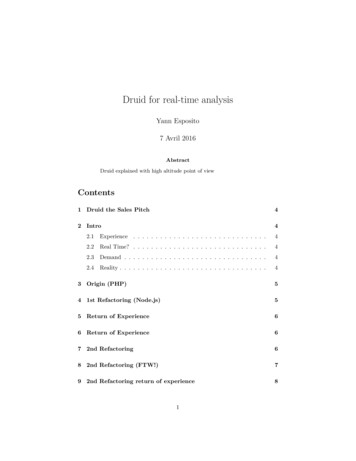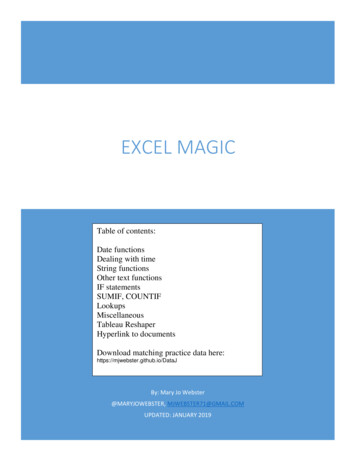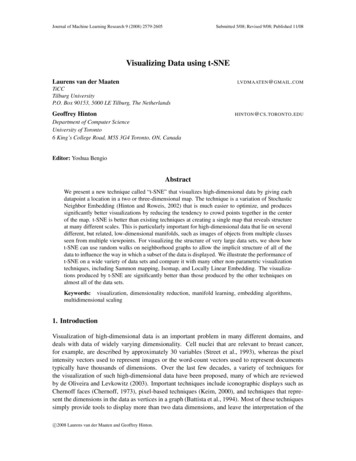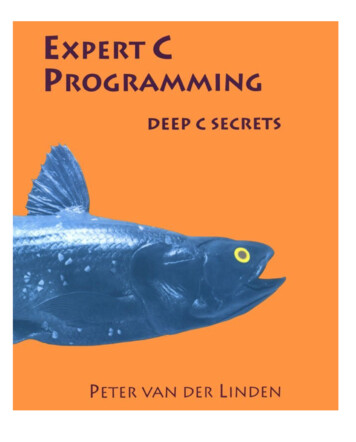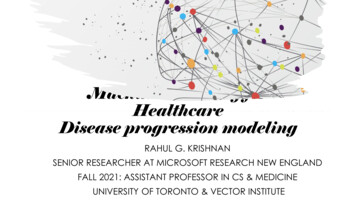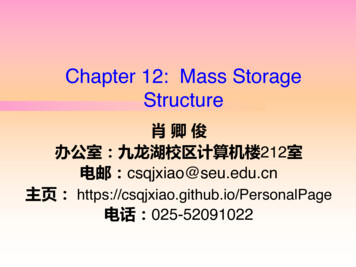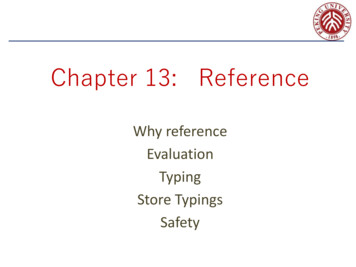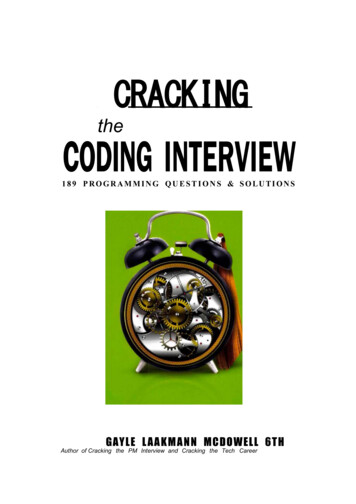
Transcription
CRACKINGtheCODING INTERVIEW189 PROGRAMMING QUESTIONS & SOLUTIONSGAYLE L A A K M A N N MCDOWELL 6THAuthor of Cracking the PM Interview and Cracking the Tech Career
CRACKINGtheCODING INTERVIEWG T H EDITION
A L S O BY GAYLE L A A K M A N N M C D O W E L LCRACKING THE P M INTERVIEWH o w TO L A N D A PRODUCT MANAGER JOB IN TECHNOLOGYCRACKING THE T E C H CAREERINSIDER ADVICE ON LANDING A JOB AT GOOGLE, MICROSOFT, APPLE, OR A N Y TOP TECH COMPANY
CRACKINGCODING INTERVIEW6th Edition189 Programming Questions and SolutionsGAYLE LAAKMANN MCDOWELLFounder and CEO, CareerCup.comCareerCup, LLCPalo Alto, CA
C R A C K I N G T H E C O D I N G INTERVIEW, SIXTH E D I T I O NCopyright 2015 by CareerCup.All rights reserved. No part of this book may be reproduced in any form by any electronic or mechanical means, including information storage and retrieval systems, without permission in writingfrom the author or publisher, except by a reviewer who may quote brief passages in a review.Published by CareerCup, LLC, Palo Alto, CA. Compiled Feb 10,2016.For more information, contact support) caieercup.com.978-0-9847828-5-7 (ISBN 13)
For Davis and Tobin,and all the things that bring us joy in life.
IntroductionIntroduction2I.4The Interview ProcessII.Why?4How Questions are Selected6It's All Relative7Frequently Asked Questions7Behind the ScenesThe Microsoft InterviewIV.V.VI.VIM9The Amazon Interview10The Google Interview10The Apple Interview11The Facebook InterviewIII. .8.12The Palantir Interview13Special Situations15Experienced Candidates15Testers and SDETs15Product (and Program) Management16Dev Lead and Managers17Startups18Acquisitions and Acquihires19For Interviewers21Before the Interview26Getting the Right Experience26Writing a Great Resume27Preparation Map30Behavioral Questions32Interview Preparation Grid32KnowYour Technical Projects33Responding to Behavioral Questions34So, tell me aboutyourself.36BigO38An Analogy38Time Complexity38Space Complexity40Drop the Constants41Drop the Non-Dominant Terms42Cracking the Coding Interview, 6th Edition
IntroductionMulti-Part Algorithms: Add vs. Multiply42Amortized Time43Log N Runtimes44Recursive Runtimes44Examples and Exercises45Vlt. Technical Questions60How to Prepare60What You Need To Know60Walking Through a Problem62Optimize & Solve Technique #1: Look for BUD67Optimize & Solve Technique #2: DfY (Do It Yourself)69Optimizes Solve Technique #3: Simplify and Generalize71Optimized Solve Technique #4: Base Case and Build71Optimize & Solve Technique #5: Data Structure Brainstorm72Best Conceivable Runtime (BCR)72Handling Incorrect Answers76When You've Heard a Question Before76The "Perfect" Language for Interviews76What Good Coding Looks Like77Don't Give Up!81VIII. The Offer and BeyondIX.82Handling Offers and Rejection82Evaluating the Offer83Negotiation84On the Job85Interview Questions87Data Structures88Chapter 1 Arrays and Strings88Hash Tables88ArrayList & Resizable Arrays89StringBuilder89Chapter 2 I Linked Lists92Creating a Linked List92Deleting a Node from a Singly Linked List93The "Runner" Technique93Recursive Problems93CrackingTheCodinglnterview.com 16th EditionVII
IntroductionChapter 3 j Stacks and Queues96Implementing a Stack96Implementing a Queue97Chapter 4 Trees and GraphsTypes of Trees100Binary Tree Traversal103Binary Heaps (Min-Heaps and Max-Heaps)103Tries (Prefix Trees)105Graphs105Graph Search107Concepts and Algorithms112Chapter 5 j Bit Manipulation112Bit Manipulation By Hand112Bit Facts and Tricks112Two's Complement and Negative Numbers113Arithmetic vs. Logical Right Shift113Common Bit Tasks: Getting and Setting114Chapter 6 j Math and Logic Puzzles117Prime Numbers117Probability119Start Talking121Develop Rules and Patterns121Worst Case Shifting122Algorithm Approaches122Chapter 7 Object-Oriented Design125How to Approach125Design Patterns126Chapter 81 Recursion and Dynamic ProgrammingVIM100130How to Approach130Recursive vs. Iterative Solutions131Dynamic Programming & Memoization131Chapter 9 System Design and Scalability137Handling the Questions137Design: Step-By-Step13SAlgorithms that Scale: Step-By-Step139KeyConcepts140Cracking the Coding Interview, 6th Edition
IntroductionConsiderations142There is no "perfect" system143Example Problem143Chapter 101 Sorting and Searching146Common Sorting Algorithms146Searching Algorithms149Chapter 11 [Testing152What the Interviewer Is Looking For152Testing a Real World Object153Testing a Piece of Software154Testing a Function155Troubleshooting Questions156Knowledge Based158Chapter 12 ] C and C 158Classes and Inheritance158Constructors and Destructors159Virtual Functions159Virtual Destructor160Default Values161Operator Overloading161Pointers and References162Templates163Chapter 13 Java165How to Approach165Overloading vs. Overriding165Collection Frame work166Chapter 141 Databases169SQL Syntax and Variations169Denormalized vs. Normalized Databases169SQi. Statements169Small Database Design171Large Database Design172Chapter 15 [Threadsand Locks174Threads in Java174Synchronization and Locks176Deadlocks and Deadlock Prevention179CrackingTheCodinglnterview.com 16th EditionVII
IntroductionX.XI.XII.Additional Review Problems181Chapter 16 Moderate181Chapter 17 Hard186Solutions191Data Structures192Concepts and Algorithms276Knowledge Based422Additional Review Problems462Advanced Topics628Useful Math629Topological Sort632Dijkstra's Algorithm633Hash Table Collision Resolution636Rabin-Karp Substring Search636AVL Trees637Red-Black Trees639MapReduce642Additional Studying644Code Library645HashMapList T, E 646TreeNode (Binary Search Tree)647LinkedListNode (Linked List)649Trie & TrieNode649XIII. Hints652Hints for Data Structures653Hints for Concepts and Algorithms662Hints for Knowledge-Based Questions676Hints for Additional Review Problems679XIV. About the AuthorJoinusat www.CrackingTheCodinglnterview.com696to download the complete solutions,contribute or view solutions in other programming languages, discuss problems from this bookwith other readers, ask questions, report issues, view this book's errata, and seek additional advice.VIMCracking the Coding Interview, 6th Edition
ForewordDear Reader,Let's get the introductions out of the way.I am not a recruiter, I am a software engineer. And as such,! know what it's like to be asked to whip up brilliant algorithms on the spot and then write flawless code on a whiteboard. 1 know because I've been askedto do the same thing—in interviews at Google, Microsoft, Apple, and Amazon, among other companies,I also know because I've been on the other side of the table, asking candidates to do this. I've combedthrough stacks of resumes to find the engineers who I thought might be able to actually pass these interviews, I've evaluated them as they solved—or tried to solve—challenging questions. And I've debated inGoogle's Hiring Committee whether a candidate did well enough to merit an offer. I understand the fullhiring circle because I've been through it all, repeatedly.And you, reader, are probably preparing for an interview, perhaps tomorrow, next week, or next year. I amhere to help you solidify your understanding of computer science fundamentals and then learn how toapply those fundamentals to crack the coding interview.The 6th edition of Cracking the Coding Interview updates the Sth edition with 70% more content: additionalquestions, revised solutions, new chapter introductions, more algorithm strategies, hints for all problems,and other content. Be sure to check out our website, CrackingTheCodingtnterview.com, to connect withother candidates and discover new resources.I'm excited for you and for the skills you are going to develop. Thorough preparation will give you a widerange of technical and communication skills. It will be well worth it, no matter where the effort takes you!I encourage you to read these introductory chapters carefully. They contain important insight that justmight make the difference between a "hire"and a"no hire."And remember—interviews are hard! In my years of interviewing at Google, I saw some interviewersask "easy" questions while others ask harder questions. But you know what? Getting the easy questionsdoesn't make it any easier to get the offer. Receiving an offer is not about solving questions flawlessly (veryfew candidates do!). Rather, it is about answering questions better than other candidates. So don't stress outwhen you get a tricky question—everyone else probably thought it was hard too. It's okay to not be flawless.Study hard, practice—and good luck!GayleL. McDowellFounder/CEO, CareerCup.comAuthor of Crggking (fig PM Interview and Cracking the Tech CareerCraekingTheCodinglnterview.com Sth Edition1
IntroductionSomething's WrongWe walked out of the hiring meeting frustrated—again. Of the ten candidates we reviewed that day, nonewould receive offers. Were we being too harsh, we wondered?I, in particular, was disappointed. We had rejected one of my candidates. A former student. One I hadreferred. He had a 3.73 GPA from the University of Washington, one of the best computer science schoolsin the world, and had done extensive work on open-source projects. He was energetic. He was creative. Hewas sharp. He worked hard. He was a true geek in all the best ways.But I had to agree with the rest of the committee: the data wasn't there. Even if my emphatic recommendation could sway them to reconsider, he would surely get rejected in the later stages of the hiring process.There were just too many red flags.Although he was quite intelligent, he struggled to solve the interview problems. Most successful candidates could fly through the first question, which was a twist on a well-known problem, but he had troubledeveloping an algorithm. When he came up with one, he failed to consider solutions that optimized forother scenarios. Finally, when he began coding, he flew through the code with an initial solution, but itwas riddled with mistakes that he failed to catch. Though he wasn't the worst candidate we'd seen by anymeasure, he was far from meeting the "bar." Rejected.When he asked for feedback over the phone a couple of weeks later, I struggled with what to tell him. Besmarter? No, 1 knew he was brilliant. Be a better coder? No, his skills were on par w i t h some of the best I'dseen.Like many motivated candidates, he had prepared extensively. He had read K&R's classic C book, and he'dreviewed CLRS'famous algorithms textbook. He could describe in detail the myriad of ways of balancing atree, and he could do things in C that no sane programmer should ever want to do.I had to tell him the unfortunate truth: those books aren't enough. Academic books prepare you for fancyresearch, and they wilt probably make you a better software engineer, but they're not sufficient for interviews. Why? I'll give you a hint: Your interviewers haven't seen red-black trees since they were in schooleither.To crack the coding interview, you need to prepare w i t h real interview questions. You must practice onreal problems and learn their patterns. It's about developing a fresh algorithm, not memorizing existingproblems.Cracking the Coding Interview is the result of my first-hand experience interviewing at top companies andlater coaching candidates through these interviews. It is the result of hundreds of conversations with candidates. It is the result of the thousands of questions contributed by candidates and interviewers. And it's theresult of seeing so many interview questions from so many firms. Enclosed in this book are 189 of the bestinterview questions, selected from thousands of potential problems.My ApproachThe focus of Cracking the Coding Interview is algorithm, coding, and design questions. Why? Becausewhile you can and will be asked behavioral questions, the answers will be as varied as your resume. Likewise, while many firms will ask so-called "trivia"questions (e.g.,"What is a virtual function?"), the skills developed through practicing these questions are limited to very specific bits of knowledge. The book will brieflytouch on some of these questions to show you what they're like, but i have chosen to allocate space to areaswhere there's more to learn.VIMCracking the Coding Interview, 6th Edition
IntroductionMy PassionTeaching is my passion. I iove helping people understand new concepts and giving them tools to help themexcel in their passions.My first official experience teaching was in college at the University of Pennsylvania, when I became ateaching assistant for an undergraduate computer science course during my second year. I went on to TAfor several other courses, and I eventually launched my own computer science course there, focused onhands-on skills.As an engineer at Google, training and mentoring new engineers were some of the things I enjoyed most. Ieven used my "20% time" to teach two computer science courses at the University of Washington.Now, years later, I continue to teach computer science concepts, but this time with the goal of preparingengineers at startups for their acquisition interviews, t've seen their mistakes and struggles, and I've developed techniques and strategies to help them combat those very issues.Cracking the Coding Interview, Cracking the PM Interview, Cracking the Tech Career, and CareerCupreflect my passion for teaching. Even now, you can often find me "hanging out "at CareerCup.com, helpingusers who stop by for assistance.Join us.GayleL. McDowellCrackingTheCodinglnterview.com 16th Edition VII
The Interview ProcessAt most of the top tech companies (and many other companies), algorithm and coding problems form thelargest component of the interview process. Think of these as problem-solving questions. The intervieweris looking to evaluate your ability to solve algorithmic problems you haven't seen before.Very often, you might get through only one question in an interview. Forty-five minutes is not a long time,and it's diffic
The 6th edition of Cracking the Coding Interview updates the Sth edition with 70% more content additiona: l questions, revise solutionsd ne,w chapte introductionsr mor, e algorithm strategies hint, s for all problems, and othe contentr B. e sure to chec ouk t our website CrackingTheCodingtnterview.com, to

